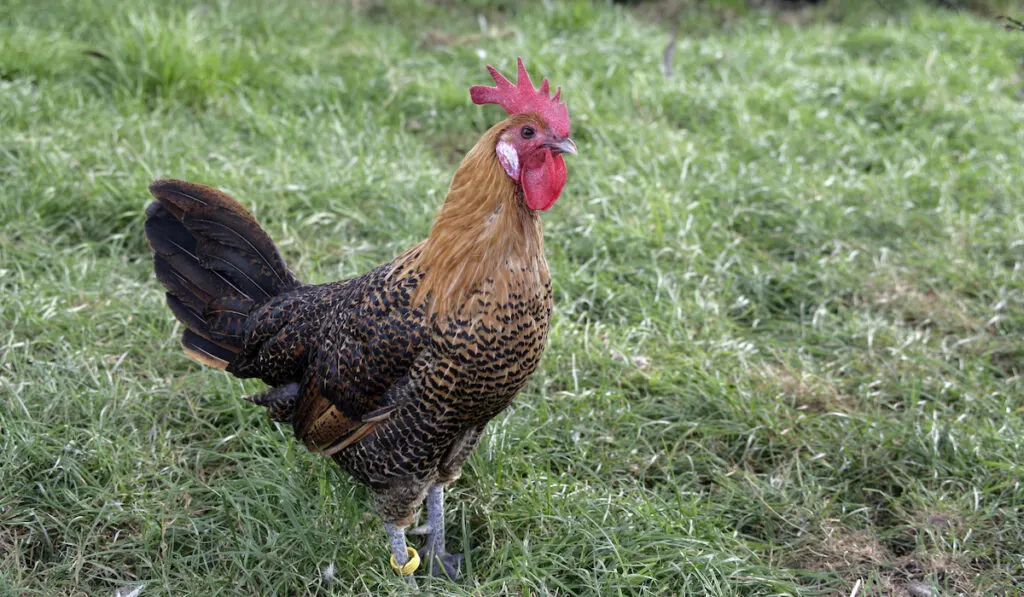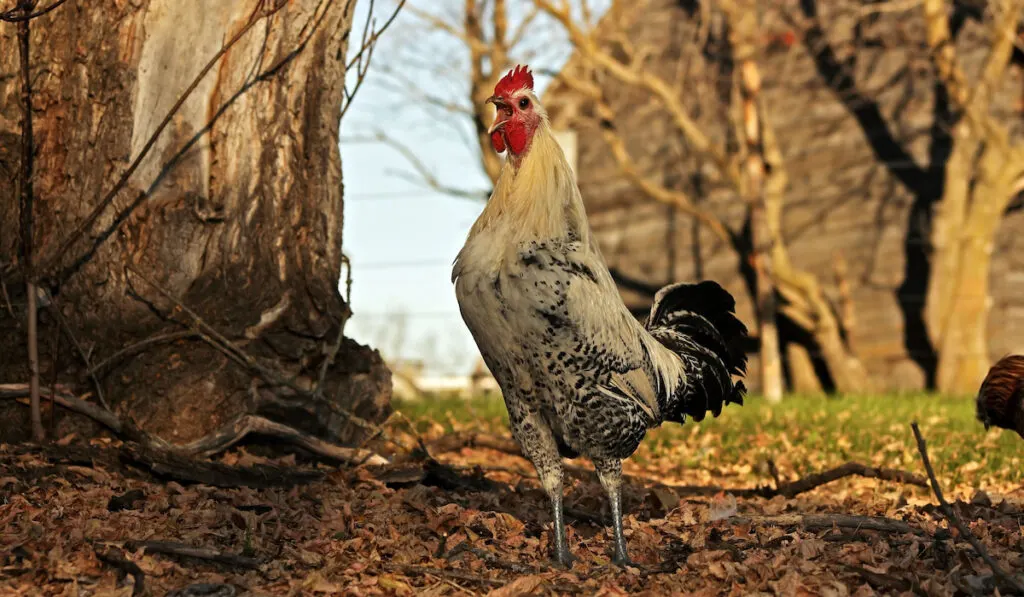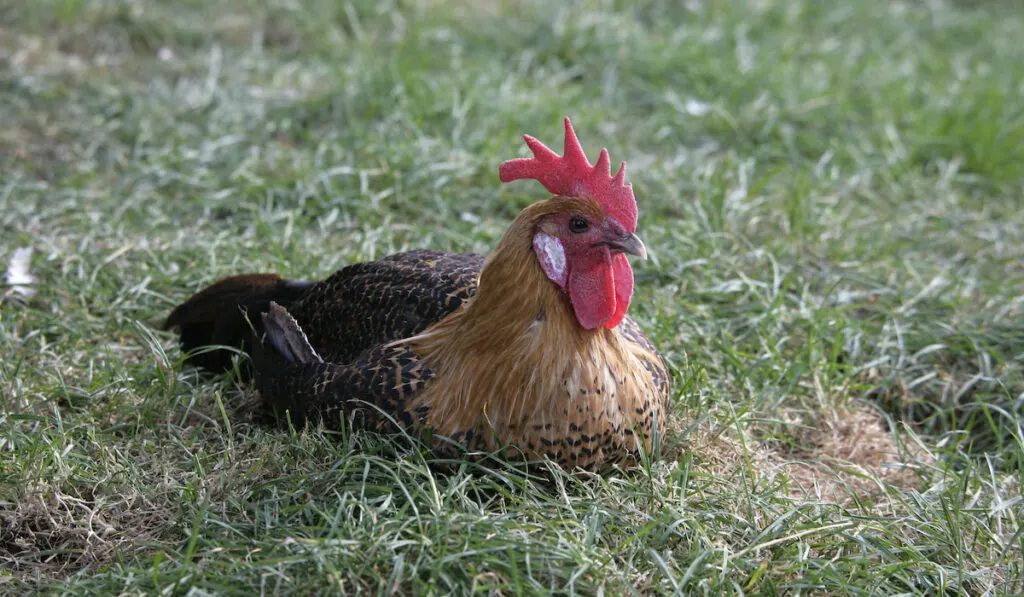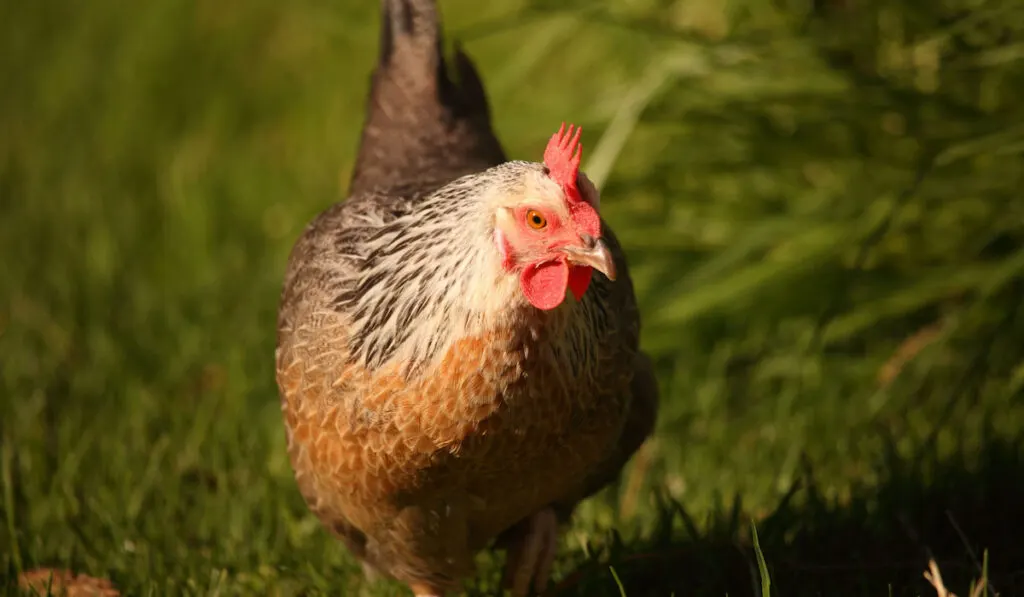Campine chickens are a domestic chicken breed with Belgian roots. Originally bred for egg production, its striking appearance quickly made it a favorite among bird enthusiasts as a show bird.
Campine chickens are an extremely rare breed of petite, beautifully feathered chickens. This breed is hardy, low-maintenance, and enjoyable to observe.
Read on to learn about the background of this pleasant breed, its distinguishing features, and its special care requirements.
Table of Contents
Campine Chicken Key Information
| Standard Male Weight: | 6 Ibs. |
| Standard Female Weight: | 4 Ibs. |
| Use: | Exhibition |
| Egg Size: | Medium |
| Egg Production: | 150 – 170 yearly |
| Lifespan: | 7 years |
| Climate Tolerance: | Warmer climates, not too cold |
| Color: | Silver, gold |
| Temperament: | Active, friendly |

Campine Chicken Breed History
The Campine is a domestic chicken breed developed in the early nineteenth century in Belgium’s Campine region.
Parent breeds have been in the region for centuries, even as far back as Caesar, who supposedly brought back a few birds similar to Campines after his expedition across northern Belgium.
The Campine chicken first arrived in England around 1899, where it was raised as a domestic fowl.
Eventually, a small group of committed British breeders improved the bird’s appearance to create a stunning show bird.
As the breed became more well-known, it was shipped from Britain to the United States, and in 1913, a Campine cockerel took first place in a poultry event at New York’s Madison Square Garden.
What Do Campine Chickens Look Like?
These birds come in only two official colors: gold and silver.
The head and neck of Campines have uniform white or rusty brown plumage that transitions to a striped pattern on their bodies. Both males and females have strikingly similar appearances.
They have a single crest on their head, and sometimes the crest may be thinner or less visible, especially if it is yet to be fully developed.
Size
Cock: 6 lbs.
Hen: 4 lbs.
Bantam Cock: 26 oz.
Bantam Hen: 22 oz.
Temperament
Campines are an energetic, intelligent, and curious breed of chickens.
Campines are full of interesting personalities, swinging between being withdrawn and friendly. This bird may at first be wary of you, but once it realizes you pose no danger, it will approach you gladly.
They are outstanding explorers, so they are great for free range and prefer to be outside most of the time.
From breeders’ observations, they remain alert at all times and are challenging to catch.
In addition, Campines are known for their flightiness; therefore, you will need to ensure that you have the proper fencing ready for this flock.
Eggs
The original purpose for breeding Campine hens was for their eggs. Hens produce white eggs that can be anything from medium to jumbo in size.
Under ideal conditions, a female Campine chicken can lay up to 200 eggs per year; however, the average is closer to 150.
Feeding
In order to produce healthy, high-quality eggs, laying hens require a diet rich in protein and calcium.
When it comes to feeding chicks, you should make sure you provide them with a high-quality, protein-rich diet that is also easy to digest.
Birds also enjoy scraps of fruit and vegetables because these help them maintain a healthy, balanced diet.

Health and Care
The Campines are a strong, healthy breed of chicken with no characteristic health problems.
However, you should know that Campines are susceptible to the same diseases as regular chickens.
Two of the most essential things you can do to protect the health of your flock include keeping the housing space clean and keeping an eye out for signs of illness.
Take preventative measures, get them vaccinated on time, and stay in touch with a local vet if you see anything out of the ordinary.
One further important guideline to follow is to always maintain a comfortable temperature in wintertime for Campines.
Their large combs and close-fitting feathers make them especially susceptible to frost and cold temperatures. They are less cold-hardy than other European breeds.

Are Campines Chickens a Good Choice for Backyard Farming?
Campine hens can be used for small-scale breeding if they are given adequate space to forage.
These hens can be kept in a free-range setting that is at least 10 square feet in size, as they like exploring and foraging. This is because of how naturally curious and active they are.
However, it is always wise to consult a Campine breeder for their expert advice and guidance before adding a new breed to your farm.
Where Can You Buy Campine Chickens?
Unfortunately, Campines are one of the species that is rapidly declining in numbers. They are one of the rarest and most endangered chicken breeds.
If you’re interested in getting into breeding these birds, the most convenient place to start is by locating a recognized breeder through an organization like the Livestock Conservancy, the American Poultry Association, or the Society for the Preservation of Poultry Antiquities.
The Rare Poultry Society in the United Kingdom is another excellent resource for information about Campine and has contact details for breeders from all over the world.
Alternative Breeds
Campine chickens are frequently compared to other types of chickens because of their similarities.
Therefore, if locating Campine birds becomes challenging, you should investigate alternative breeds of hens that may spark your interest.
1. Egyptian Fayoumis
When it comes to appearance, silver Campines can easily be mistaken for Egyptian Fayoumis. It is not surprising considering they are closely related breeds.
Even though Campines are much more friendly, Egyptian Fayoumis lay roughly the same number of eggs and produce approximately the same amount of meat as Campines.
2. Dorkings

Dorkings’ plumage resembles that of Campine chickens. They also have a similar temperament and lay a comparable number of eggs.
Size is the main distinction. The Campine is a smaller bird than the Dorking.
Although this may seem like a drawback at first, it actually makes this breed very useful for those interested in egg and meat production.
Final Thoughts
Campines are a great breed with outstanding characteristics that make them suitable for both a backyard garden and a rural free-range setup.
They also produce an abundance of huge, healthy eggs—more than enough to supply your family’s needs.
Unfortunately, this is a very uncommon and unique breed, so you will have to put in some extra effort to find some of these birds.
However, if you breed them, you can take pride in the fact that you are one of the few people helping to ensure this beautiful bird’s survival.
Resources
- https://petkeen.com/campine-chicken/
- https://www.farmow.com/breed/campine-chicken-
- https://www.poultrypages.com/campine-chickens/
- https://cs-tf.com/campine-chicken/
- https://petkeen.com/campine-chicken/
- https://en.wikipedia.org/wiki/Campine_chicken
- https://domesticanimalbreeds.com/campine-chicken-breed-everything-you-need-to-know/
- https://breeds.okstate.edu/poultry/chickens/campine-chickens.html
